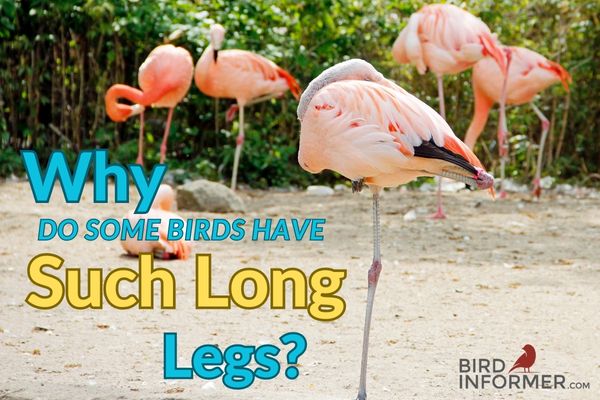Contents
Are you trying to learn more about birds with long legs? Continue reading to discover a number of different bird species that have long legs based on their body size and design.
Birds with long legs come in all shapes and sizes. Some have large bodies and large legs, like flamingos or ostriches. Others are smaller with long legs relative to the size of their frame. The American Bittern and the Great Egret come to mind. Their long legs keep them dry while in search of food.
These interesting creatures are an enigma to many, but long-legged birds are fascinating, to say the least. Today, I will cover the following topics about these majestic birds:
- Top 10 bird species with long legs
- Which birds stand on one leg
- Why do birds have long legs
- and other important information
To learn more about birds with long legs and other related topics, please continue reading below.
Top 10 Long Legged Birds
According to CoachellaValleyPreserve.org,
Birds with long legs are usually carnivorous or insectivorous birds living in swamps, lakes, areas with a high level of humidity, and near water in general.
These water birds tend to feast on invertebrates, fish, insects, frogs, and other water-dwelling creatures. They love a wide range of delicacies found in bodies of water, within the silt and sand around the water’s edge, and they’ll even find them in the mud.
Which birds have long legs? We’ll share ten popular birds with long legs below of varying geniuses and bird families.
Ostriches
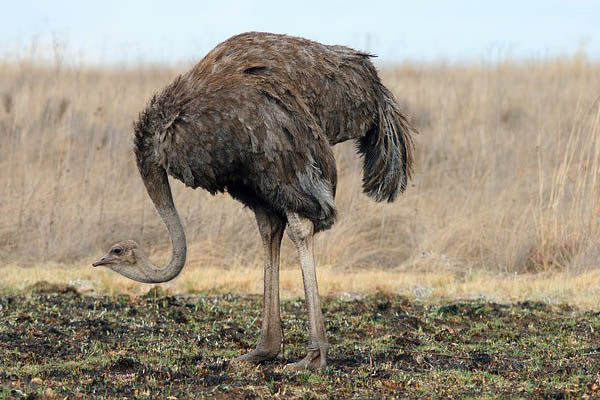
Ostriches are very large birds that do not possess the ability to fly. They are members of the S. camelus species, and they are part of the Struthionidae family.
There are a lot of interesting facts about the ostrich that people don’t know about. For starters, these birds are incredibly fast and can sprint up to 70 km/h. Their feet only have two toes, which aids in their running.
Mainly, ostriches have long legs because they aren’t capable of flight, so they need them to get from one place to another either by walking or running. Since this bird is so large and heavy, it doesn’t possess the ability to fly because it could weigh up to 320 pounds. Its stubby wings are not powerful enough to lift it off the ground.
But having long legs gives the ostrich the ability to move between 10-16 feet per stride, with its long and powerful legs. The legs can even be used as weapons, which can kick potential predators or human beings with incredible strength and brute force.
Have You Ever Seen An Ostrich Run?
Do you know how fast they can go? You might be surprised to find out! Click the button below to check it out!
Great Egret
The Great Egret also goes by the name common Egret. This large bird has long orange legs and white plumage. Many people also call it a white heron or big heron because of its large frame and overall body size.
You can find great egrets in a number of different environments, although most commonly, they live in subtropical or tropical areas.
Great egrets love to build their nests in trees, and they do so in colonies located by the water. Believe it or not, these colonies become so large that they can be seen from space.
The Great White Egret enjoys feasting on a wide array of prey, including crayfish, small rodents, frogs, and fish. Frequently, these birds methodically stalk their prey by moving very slowly before capturing them in their beaks.
Great Blue Heron
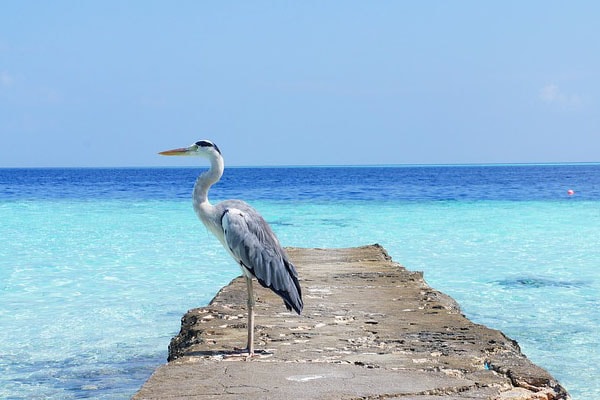
Known as a wading bird, the Great Blue Heron is a member of the Ardeidae family of herons that are commonly found all throughout North America. By being in this family of birds, it shares close relations with night herons, gray herons, little blue herons, and cocoi herons too.
According to GuideYourPet.com,
The great blue Heron was one of many species originally described by Carl Linnaeus in his 18th-century work, Systema Naturae. Great blue herons can acclimate to all but the harshest environments.
Even more important, these birds tend to remain in warm climates because food sources are readily available. But, there are recorded instances of great blue herons going as far north as Alaska.
These migratory birds move in large concentrations and take their leave of northern regions beginning in August. They tend to make their way to warmer climates in the south during the late fall months of October and November. They’ll stay down south until late February or early March, during which they will then leave to head back to their preferred breeding grounds.
Whooping Crane
The whooping crane is a large bird that lives in North America. In fact, it’s North America’s tallest native bird in existence. At its highest, the whooping crane will stand roughly 4.9-5.3 ft tall, which is really tall for a bird.
Adult whooping cranes have a Brown crown, white cheeks, and a black chin. They also have a white body and gray neck. On average, they typically weigh 15 pounds.
While flying, they keep their necks pointed straight ahead while flying for long distances. Their wings tend to contain dark marks, which really stand out.
American Bittern
The American Bittern is a wading bird that happens to be a member of the Heron family. They breed in Canada and the central and northern portions of the US. They spend their winters in the US in Florida, the Caribbean islands, and other Gulf Coast states. They will even spend their winter in portions of Central America.
Typically, this bird is most distinguishable by its brownish-yellow facial disk, its 30-inches tall large size, and on each side of its neck, it contains white stripes on the throat. The plumage on its back is buff-colored as well.
Some facts about the American bittern include:
- This bird species has a loud call that it uses to communicate with other birds of its species. Some nicknames include state-driver, thunder-pumper, and Meyer-drum because of their loud resounding calls.
- American Bittern’s appear cross side because they point their eyes in a downward-facing direction. This gives them a comical appearance. More than likely, they continuously look toward the ground in an effort to find and potentially capture their prey.
- The American bittern has an elaborate courtship display that rarely gets seen. Male members of the species arch their back, make their necks shorter, dip forward, point their breasts toward the ground, and make a loud booming sound aiming it toward a female that it’s attempting to impress. Males and females also perform difficult aerial displays during courtship.
Sandhill Crane
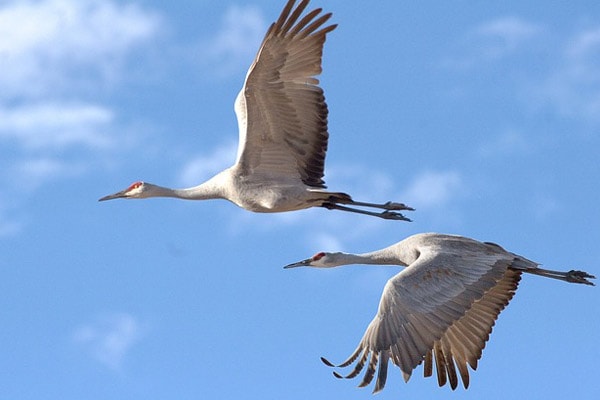
Sandhill Cranes are large birds found in North America for the most part, although you can find them in extreme temperatures within northeastern Siberia. More commonly, these birds can be found living in habitats near lakes and toward the edge of marshes. Although they are frequently found along the shorelines of rivers as well.
Sandhill cranes are very large birds with black heads with red feathers around their eyes and white cheeks, and their body plumage is gray-brown in color.
Black-Crowned Night-Heron
The black-crowned night heron is a member of the Heron family that’s typically found all across the globe. They spend the majority of their time in forested regions, coastal areas, and wetlands. These birds range from Alaska and Canada and as far south as the Caribbean.
These birds are small and squat, but they definitely have very thick bodies and thick proportions. They have flat heads, pointed bills, and thick necks. This bird is very commonly found throughout the North American wetlands.
Greater Flamingo
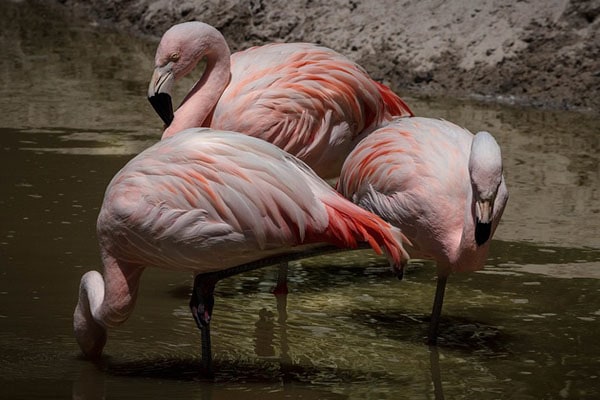
The Greater Flamingo is a long-legged bird that just about everybody is seen at some point in their life. It’s an iconic migratory bird that spends the bulk of its time in tropical locations, including shallow coastal lagoons and title flats in the Middle East, southern Asia, Africa, and the southern portion of Europe.
Specifically, their diet typically consists of shrimp, seeds, mollusks, insect larvae, crustaceans, and algae. When times are tough, and food is scarce, they will even feed on plants.
Greater Flamingos know how to swim but tend to walk on land at times to reach better food sources. If it needs to go long distances, the greater Flamingo does possess the ability to fly.
While feeding, the greater Flamingo will feed head-down, and it doesn’t raise its head while swallowing food. It has a mobile upper jaw, which isn’t fixed to its skull, which gives it the ability to swallow with its head pointing downward.
Wood Stork
Wood Storks are large birds with black wings and white bodies. Typically, the male member of the species is larger than the female, although female wingspans tend to remain longer than their male counterparts.
On average, the Flamingo weighs anywhere from 4-5 pounds and is typically 39 inches tall. These long-lived birds can live until they reach 30 years old, even in the wild. The oldest recorded wood stork in history is 38 years old.
While flying, the wood stork makes noise as it builds momentum. Typically, during this time, its wings will make a loud clapping sound. This noise is used to communicate with other wood storks.
White-Faced Ibis
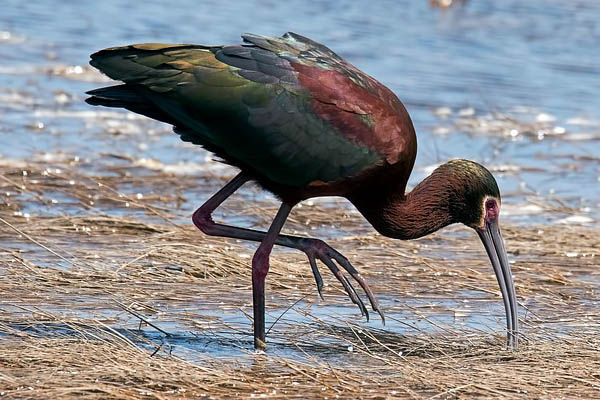
The white-faced Ibis is a wading bird of medium size. This bird tends to have a long curved bill, black legs, and white plumage. The feathers on its back are blue-gray and contain glossy streaks of green or purple, which provides an iridescent appearance.
Their feathers are fluffy and loose, which makes it appear that the white-faced ibises’ feathers are ruffled. This bird is capable of short bursts of flight, but it doesn’t fly for long distances.
Which birds stand on one leg?
Flamingos are the most commonly known bird to stand on one leg. But they aren’t the only bird with this capability.
According to A-Z Animals,
Birds that stand on one leg do so for a number of reasons. Primarily, it’s due to an adaptation that allows birds to retain heat more efficiently. Birds possess a complex web of arteries and veins that use concurrent blood flow to exchange heat… By standing on one leg, these birds cut down on the amount of heat loss through their feet and legs.
Now that we know why some birds stand on one leg, here is a list of six birds that possess this ability. Our list includes:
- White Stork
- Canada Goose
- Budgerigar
- Red-Tailed Hawk
- Great Blue Heron
- American Flamingo
Why do birds have long legs?
According to Audubon Adventures,
Long legs help keep their feathers high and dry when wading into the water in search of food. The benefits of wading birds’ long, thin, spread-out toes are threefold: thin toes are easier to pick up and put down when walking in water and squishy mud.
Birds with long legs tend to live near saltwater marshes or freshwater marshes. Why? They live in these areas to gain easy access to food, which is very common for wading birds of this nature.
For the most part, their long legs are thin and very easy to maneuver. These wading birds need long legs to make it easy to walk through the water. They must do so in order to find and catch prey, which is what they need to do to feed themselves and their young ones.
Like many aquatic birds, they have webbed feet, long legs, and sharp claws. Certain aquatic birds also possess oily feathers to make it easy for the water to roll off their backs. This helps them remain clean and water-resistant. Many ducks have oily feathers, for example.
| Birds With Really Long Legs | Species | Family |
|---|---|---|
| Ostrich | S. camelus | Struthionidae |
| Great Egret | A. alba | Ardeidae |
| Great Blue Heron | A. herodias | Ardeidae |
| Whooping Crane | G. americana | Gruidae |
| American Bittern | B. lentiginosus | Ardeidae |
| Sandhill Crane | A. canadensis | Gruidae |
| Black-Crowned Night-Heron | N. Nycticorax | Ardeidae |
| Greater Flamingo | P. roseus | Phoenicopteridae |
| Wood Stork | M. americana | Ciconiidae |
| White-Faced Ibis | P. chihi | Threskiornithidae |

